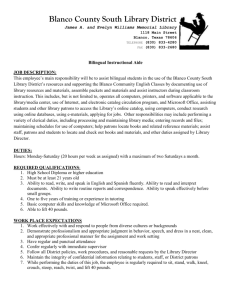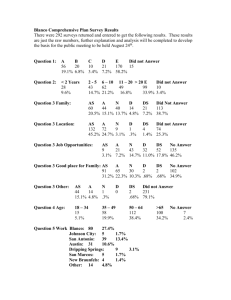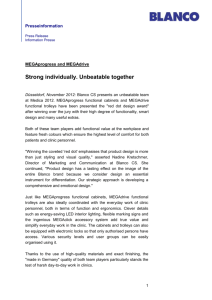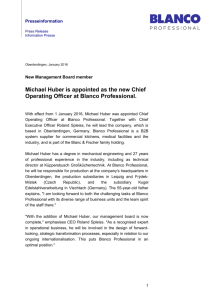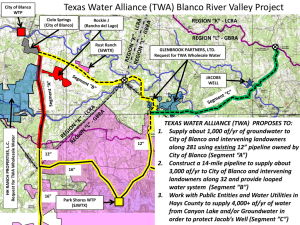Bineli_Thierry_Poster - SWISS GEOSCIENCE MEETINGs
advertisement
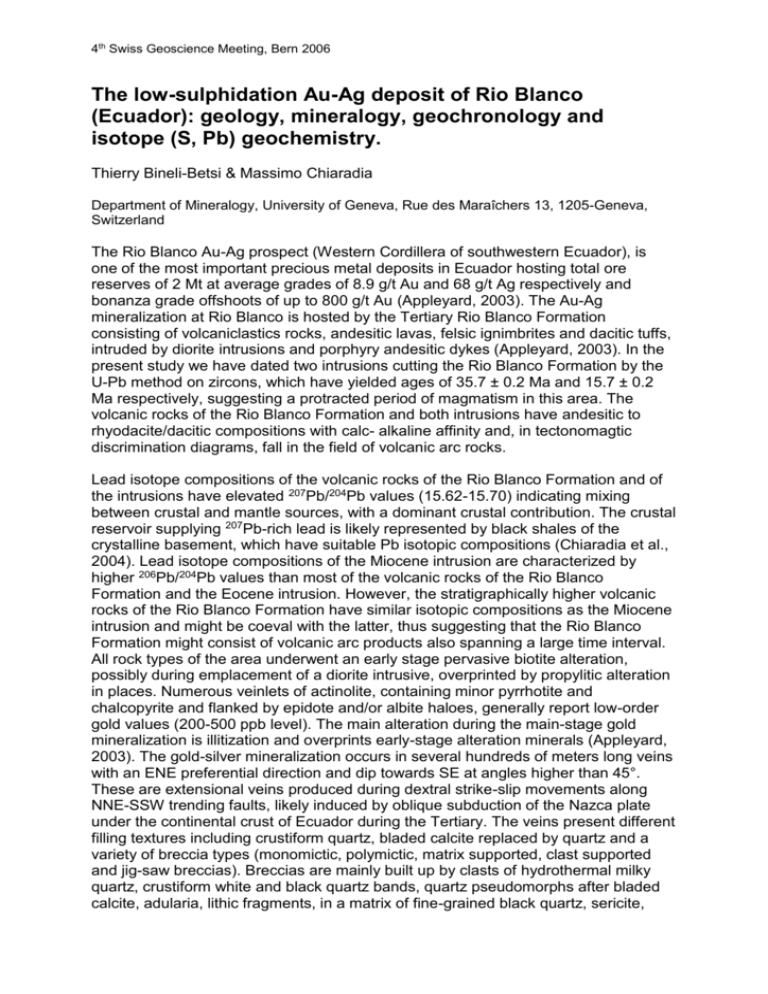
4th Swiss Geoscience Meeting, Bern 2006 The low-sulphidation Au-Ag deposit of Rio Blanco (Ecuador): geology, mineralogy, geochronology and isotope (S, Pb) geochemistry. Thierry Bineli-Betsi & Massimo Chiaradia Department of Mineralogy, University of Geneva, Rue des Maraîchers 13, 1205-Geneva, Switzerland The Rio Blanco Au-Ag prospect (Western Cordillera of southwestern Ecuador), is one of the most important precious metal deposits in Ecuador hosting total ore reserves of 2 Mt at average grades of 8.9 g/t Au and 68 g/t Ag respectively and bonanza grade offshoots of up to 800 g/t Au (Appleyard, 2003). The Au-Ag mineralization at Rio Blanco is hosted by the Tertiary Rio Blanco Formation consisting of volcaniclastics rocks, andesitic lavas, felsic ignimbrites and dacitic tuffs, intruded by diorite intrusions and porphyry andesitic dykes (Appleyard, 2003). In the present study we have dated two intrusions cutting the Rio Blanco Formation by the U-Pb method on zircons, which have yielded ages of 35.7 ± 0.2 Ma and 15.7 ± 0.2 Ma respectively, suggesting a protracted period of magmatism in this area. The volcanic rocks of the Rio Blanco Formation and both intrusions have andesitic to rhyodacite/dacitic compositions with calc- alkaline affinity and, in tectonomagtic discrimination diagrams, fall in the field of volcanic arc rocks. Lead isotope compositions of the volcanic rocks of the Rio Blanco Formation and of the intrusions have elevated 207Pb/204Pb values (15.62-15.70) indicating mixing between crustal and mantle sources, with a dominant crustal contribution. The crustal reservoir supplying 207Pb-rich lead is likely represented by black shales of the crystalline basement, which have suitable Pb isotopic compositions (Chiaradia et al., 2004). Lead isotope compositions of the Miocene intrusion are characterized by higher 206Pb/204Pb values than most of the volcanic rocks of the Rio Blanco Formation and the Eocene intrusion. However, the stratigraphically higher volcanic rocks of the Rio Blanco Formation have similar isotopic compositions as the Miocene intrusion and might be coeval with the latter, thus suggesting that the Rio Blanco Formation might consist of volcanic arc products also spanning a large time interval. All rock types of the area underwent an early stage pervasive biotite alteration, possibly during emplacement of a diorite intrusive, overprinted by propylitic alteration in places. Numerous veinlets of actinolite, containing minor pyrrhotite and chalcopyrite and flanked by epidote and/or albite haloes, generally report low-order gold values (200-500 ppb level). The main alteration during the main-stage gold mineralization is illitization and overprints early-stage alteration minerals (Appleyard, 2003). The gold-silver mineralization occurs in several hundreds of meters long veins with an ENE preferential direction and dip towards SE at angles higher than 45°. These are extensional veins produced during dextral strike-slip movements along NNE-SSW trending faults, likely induced by oblique subduction of the Nazca plate under the continental crust of Ecuador during the Tertiary. The veins present different filling textures including crustiform quartz, bladed calcite replaced by quartz and a variety of breccia types (monomictic, polymictic, matrix supported, clast supported and jig-saw breccias). Breccias are mainly built up by clasts of hydrothermal milky quartz, crustiform white and black quartz bands, quartz pseudomorphs after bladed calcite, adularia, lithic fragments, in a matrix of fine-grained black quartz, sericite, 4th Swiss Geoscience Meeting, Bern 2006 carbonates and accessory chlorite and actinote-tremolite. The matrix of the breccias contains also sulfide minerals consisting mostly of pyrite, pyrrhotite, pyrargirite (65.358 wt.% Ag), tetrahedrite (33.6-22% Ag), As (up to 2 wt.%)-bearing tetrahedrite (205.7 wt.% Ag), arsenopyrite and accessory amounts of Fe-rich (10.0-10.5 wt.%) sphalerite, galena, chalcopyrite and electrum (40-56% Ag). The total amount of sulfides is <2 %. Electrum is concentrated in volumes of few cm 3 within the breccia where it is associated mainly with pyrrhotite, but also with pyrite and pyrargirite, and occasionally with sphalerite. In these small volumes electrum occurs in grains ranging in size from a few µm to several tens of µm both interspersed within finegrained quartz together with the above-mentioned sulfides and in direct contact with or within pyrrhotite and/or pyrite. Gold-rich electrum occurs towards greater depths, whereas the highest Ag grades are encountered at shallow levels of the deposit. The δ34S values of pyrite and galena from the veins range from -3 to +4 ‰, consistent with a magmatic source of S. Pyrrhotite from disseminated ore within a host, altered lava yielded a δ34S value of -23.2 ‰ indicating a contribution from sedimentary S, probably related to black shales of the underlying basement, which are also found as clasts in the breccias. Lead isotope compositions of 6 vein sulfides and the lava-hosted pyrrhotite are identical and fall within the field of isotopic compositions of the Miocene intrusion, possibly suggesting a genetic association with the latter. The textures as well as the gangue and sulfide mineralogy of Rio Blanco are typical of an epithermal low sulfidation deposit (Hedenquist et al., 2000). In low sulfidation systems gold is transported as a bisulfide complex and its precipitation usually occurs by boiling (Hedenquist, 1991). The presence of bladed calcite testifies the occurrence of boiling in the mineralized veins at Rio Blanco. However, the Au-Ag mineralization always postdates the formation of bladed calcite, which occurs as clasts within the Au-bearing breccia matrix. Therefore, an alternative process of gold precipitation might have to be envisaged at Rio Blanco, such as sulphidation reaction of the hydrothermal Au-bearing fluid with Fe-bearing clasts within the breccia. Such a process is supported by the frequent occurrence of pyrite around clasts and of pyrite, pyrrhotite and gold within relict, now completely silicified clasts of the breccias. S and Pb isotopes of the vein sulfides are consistent with a magmatic origin of these elements in the main ore. The similarity of Pb isotope compositions of the vein sulfides with those of the Miocene intrusion might indicate a genetic relationship of the Rio Blanco mineralization with the latter. The still pending results of Ar-Ar dating of sericite associated with the mineralization will clarify the temporal relationship of this intrusion with the Au-Ag mineralization. REFERENCES Appleyard, N. (2003): Rio Blanco, Ecuador. Technical Report for International Minerals Corporation, 90 p. Hedenquist, J. W. (1991): Boiling and dilution in the shallow portion of the Waiotapu geothermal system,New Zealand. Geochimica et Cosmochimica Acta 55: 2753-2765. Chiaradia, M., Fontboté, L. & Paladines, A. (2004): Metal sources in mineral deposits and crustal rocks of Ecuador (1°N-4°S): a lead isotope synthesis. Economic Geology 99: 1085-1106. Hedenquist J. W., Arribas A. J. & Gonzales-Urien E. (2000): Exploration for epithermal gold deposits. Reviews in Economic Geology 13: 245-277.
